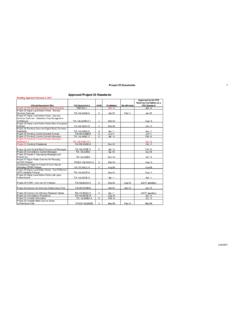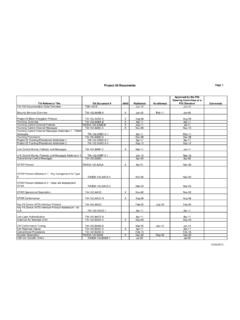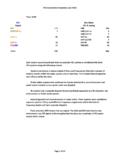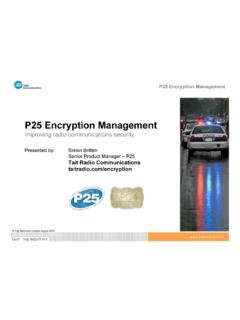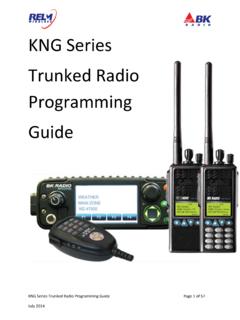Transcription of A Guide to Project 25 Subscriber and Infrastructure ...
1 Project 25 Technology Interest Group, capabilities Guide , 1 A Guide to Project 25 Subscriber and Infrastructure equipment capabilities as Standardized in the TIA-102 Series Prepared by the Project 25 Technology Interest Group Version March 2015 Project 25 Technology Interest Group, capabilities Guide , 2 1. Document Overview This document is intended as a Guide that lists the capabilities of Subscriber and Infrastructure equipment enabled by the TIA-102 series of published standards. These standards are referred to as the Project 25 Standard . The most common differentiator for both Subscriber and Infrastructure equipment is the air interfaces. This Guide groups the listed equipment capabilities by the currently available standardized air interfaces: FDMA Conventional FDMA Trunking TDMA Trunking For each air interface grouping, this Guide provides both a summary of capabilities and a more detailed listing which expands on the capabilities identified in the summary.
2 This approach is used for both Subscriber and Infrastructure equipment . The TIA-102 series of standards, referred to as the Project 25 Standard, result from a sequential but iterative process: Project 25 publishes the Project 25 Statement of Requirements (SOR) for user desired features and capabilities . TIA publishes the TIA-102 series of technical documents as completed standards for specific features and capabilities . Project 25 adopts the completed TIA-102 standards and they become part of the Project 25 Standard . Within the tables of this Guide , detailed references to the TIA-102 series documents are included. The format of the Guide includes space for detailed references to the Project 25 Statement of Requirements (SOR) when available into future editing.
3 Both the TIA-102 series and the Project 25 Statement of Requirements continue to evolve together as the needs of users and technology continue to evolve. Similarly, this document will also evolve over time. Subsequent versions will continue to aid the understanding of the standardized features and capabilities available to the Project 25 community of users and planners. This first published release, version , included capabilities only for Subscriber equipment . The second published release, version included clarifications only. The third published release, version added capabilities for the Trunked ISSI/CSSI and the Conventional FSI. Project 25 Technology Interest Group, capabilities Guide , 3 VERSION HISTORY Version Number Change Overview First published release covers Subscriber capabilities only Offline working versions adding clarifications Second published release containing various clarifications and updates associated with TIA-102 Standards publications occurring since version publication Offline working version adding clarifications and Trunked ISSI/CSSI section 9 & 10 and Conventional FSI section 11.
4 Approved by PTIG Added P25 SoR references provided by P25 UNS Working Group and various editorial corrections Introduction To This Document As A Guide To Project 25 Features And capabilities : The TIA-102 series and the Project 25 Statement of Requirements are complementary but they do not always match at a specific point in time. In most cases, this disparity exists because some of the capabilities identified in the SoR have not been developed into TIA-102 Standards and adopted by the Project 25 Steering Committee to be included in the P25 Suite of Standards. This document has multiple purposes: 1. The listing of the services and features that have been defined in published TIA-102 Standard documents with a corresponding reference to the services and feature descriptions found in the P25 Statement of Requirements.
5 2. The listing of the P25/TIA-102 services and features broken out by Subscriber and fixed Infrastructure network. 3. The listing of the P25 /TIA-102 services and features broken out by conventional and trunked operation. 4. The linking of defined P25/TIA-102 services and features to one or more of the P25 Standard interfaces. 5. Public safety Subscriber equipment supports conventional FM analog voice operation in the VHF, UHF and 700/800 MHz bands. The FCC requires public safety Subscriber equipment to support the FCC defined interoperability channels. Therefore, the FM analog interface, TIA-603, is also noted in the conventional FDMA voice section. 6. It should not be expected that ALL of the services and features contained in these tables will be included in a P25 Subscriber unit.
6 The P25/TIA-102 Standard defines many services and features. System operators and users will need to make choices as to which features and services are required for their particular situation. 7. It should not be expected that ALL of the services and features contained in these tables will be included in P25 Fixed Network equipment . The P25/TIA-102 Standard defines many Project 25 Technology Interest Group, capabilities Guide , 4 services and features. System operators and users will need to make choices as to which features and services are required for their particular situation. At a minimum, two types of tables are provided in each section. There will be a high level summary table titled Feature Summary for the services followed by a second table with details about the features under each service titled Feature Detail.
7 The high level summary will also list the frequency bands. Many of the P25/TIA-102 services and features are described in the TIA-102 Documentation Suite Overview document. These descriptions provide details without the technical detail found in the TIA-102 core technical standard documents. In the case of FDMA Conventional Non-Voice Service there will be two sections that correspond to different operational configurations. One section will apply to two types of conventional operations; (1) conventional operations where a single transmitting Subscriber communicates directly (no repeater) to one or more subscribers typically using a single frequency; and, (2) conventional operation where a single transmitting Subscriber communicates to a repeater and that repeater re-transmits the same message to one or more subscribers using a frequency different than the frequency used by the transmitting Subscriber .
8 The second section for FDMA Conventional Non-Voice Service will be for fixed network equipment (FNE) systems. These are conventional systems where the transmitting Subscriber communicates to a repeater that is linked via wireline to a fixed host computer or server. While the majority of the services and features for those different operational configurations are the same, important differences do exist. These differences will be seen in the Feature Detail tables. Blank columns for the P25 Subscriber Common Air Interface (CAI), analog FM standard (TIA-603), analog with signaling (examples include but are not limited to: CTCSS, DCS, MDC-1200, Type 99, GE-STAR), Mobile Data Terminal Interface (MDTI), and the Key Fill Device Interface (KFDI) are provided for the user to inventory the current features on their existing system or to note desired features for future systems.
9 Suggested format is to enter H ( Have ) for a service, feature or capability in the user s current system and a W ( Want ) if it is needed in the new system. The P25 SoR reference column entries were blank in earlier versions of this Guide . This version provides references to the P25 SoR for each row in each Detailed Table. The published standards contain significantly more detail than the P25 SoR. This sometimes results in multiple capabilities listed in this document all tracing to a single item in the P25 SoR. Note also that when a reference is made to a section heading in the P25 SoR, the reference is intended to include all the P25 SoR sub-items associated with the section heading. Note that the TIA-102 column in each table does not intend to identify the latest document revisions or appendices; determination of the latest versions is left to the reader.
10 Project 25 Technology Interest Group, capabilities Guide , 5 Note that DES Encryption is included in several tables. NIST has deprecated DES by withdrawing the following standard: FIPS PUB 46-3 DES . AES should be considered the preferred P25 encryption standard. Project 25 Technology Interest Group, capabilities Guide , 6 Content - Sections 1. Document Overview .. 2 2. FDMA Conventional - Voice Service .. 8 3. FDMA Conventional Non-Voice Service; SU-to-SU & SU-Repeater-SU (No FNE) .. 10 4. FDMA Conventional Non-Voice Service; SU-Fixed Network equipment (FNE) .. 13 5. FDMA Trunked - Voice Service .. 17 6. FDMA Trunked Non-Voice Service .. 20 7. TDMA Trunked - Voice 24 8. TDMA Trunked Non-Voice Service .. 27 9. Fixed Network equipment - Trunked ISSI/CSSI Voice Services.


